Enlil › Ennin › Roman Mills » Origins and History
Articles and Definitions › Contents
- Enlil › Who Was?
- Ennin › Who Was?
- Roman Mills › Antique Origins
Ancient civilizations › Historical places, and their characters
Enlil › Who Was?
Definition and Origins
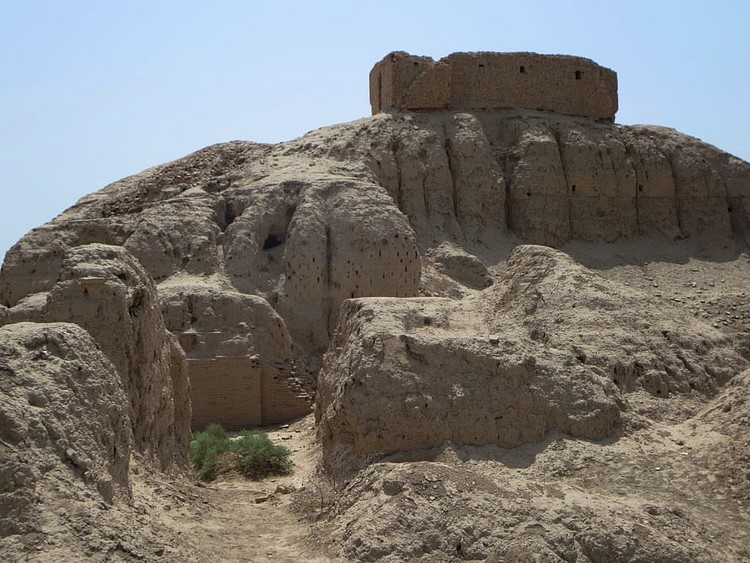
Enlil (also known as Ellil and Nunamnir) was the Sumerian god of the air in the Mesopotamian Pantheon but was more powerful than any other elemental deities and eventually was worshiped as King of the Gods. He was the son of the god of the heavens Anu (also known as An) and, with Anu and Enki (god of wisdom), formed a triad which governed the heavens, earth, and underworld or, alternately, the universe, sky and atmosphere, and earth. After Anu, Enlil was the most powerful of the Mesopotamian gods, keeper of the Tablets of Destiny which contained the fates of gods and humanity, and considered an unstoppable force whose decisions could not be questioned.
The city of Nippur was the central seat of Enlil's worship at the temple known as 'the Mountain House,' but he was also honored in Babylon and other cities. He was the only god with direct access to Anu, who controlled the universe, and was highly respected for this position, but at the same time, his decisions seem to be final without regard to Anu, and so it can seem unclear what Anu's influence over Enlil was.
Although his name translates as 'Lord of Air,' he was clearly considered much more than a sky god. He is referred to as 'Father of the Black-headed People' (the Sumerians ) and 'Father of the Gods' in some inscriptions, but other ancient texts make clear that Enki conceived of creating human beings and the gods were either born of Anu and Uras (Heaven and Earth) or, according to the Babylonian Enuma Elish, from Apsu and Tiamat (Fresh and Salt Water) or their children Anshar and Kishar (also Heaven and Earth). Scholar Stephen Bertman tries to clarify Enlil's position, writing :
If Anu was the heavenly chairman of the board, Enlil was the heavenly corporation's CEO, or chief executive officer. His cosmic headquarters were based at Nippur. His executive assistant was his son Nuska. Enlil/Ellil was a family man, married to Ninlil (also called Sud), and with her he raised a brood that included - among others - the moon-god Nanna /Sin, the sun-god Utu-Shamash, the weather god Ishkur/Adad, and the love-goddess Inanna / Ishtar. (118)
Although that explanation may clarify somewhat, Enlil is also sometimes referred to as the son of Enki and Ninki (Lord and Lady Earth and not Enki, the god of wisdom) while Enki, the god of wisdom, is established as the twin brother of Ishkur/Adad, which would make him obviously another son of Enlil, which he was not. Further, although Inanna is frequently depicted as a daughter of Enki, she is also mentioned as Enlil's child. All of these seeming contradictions stem from Mesopotamia 's long history and the different cultures which adopted Sumerian gods and made them their own with additions and alterations to their stories. Sometimes these changes expand upon or continue older stories, but often different scribes in various eras simply rewrote the tales to suit their purposes.
Worship of Enlil dates from the Early Dynastic Period I (c. 2900-2700 BCE) at Nippur and firmly from the time of the Akkadian Empire (2334 - c. 2083 BCE) down until he was absorbed and assimilated into the god Marduk during the reign of Hammurabi of Babylon (1792-1750 BCE). Even after that time, however, he continued to be widely honored throughout Mesopotamia, and so it is not surprising that different stories, from different regions and various eras, should depict him with different characteristics and details. His importance as the supreme god for hundreds of years is reflected in the roles he plays in Mesopotamian myths.
ENLIL & NINLIL
In the early myth known as Enlil and Ninlil, Enlil is seen as a young god living in the city of Nippur before the creation of human beings. Nippur is an urban center of the gods in this story and governed by divine law. Ninlil (also known as Sud) is a young and beautiful goddess who is attracted to Enlil as he is to her. Ninlil's mother, Nisaba (goddess of writing and scribe of the gods), cautions her against going to bathe in the river and encouraging the advances of young Enlil, warning her against the dangers of losing her virginity. Ninlil ignores this advice, however, goes to the river, and is seduced by Enlil. She becomes pregnant and gives birth to the moon god Nanna. Enlil must then go to Nisaba and ask for her daughter's hand in marriage.
IN THE MYTH OF ANZU, ENLIL WAS VIEWED AS THE EPITOME OF KINGSHIP, ACTING AS A MEDIATOR BETWEEN THE HIGHER POWERS & THE MORTAL WORLD.
Afterwards, as Enlil is walking through the city, he is arrested by the other gods for being ritually impure and exiled from the city to the underworld. The charge against him seems to have nothing to do with Ninlil's seduction, however. Ninlil is also arrested and exiled and follows him out of the gates but at some distance behind him. Enlil speaks to each of the keepers of the gates or important personages of the underworld instructing them not to tell Ninlil where he has gone if she should ask. He then disguises himself as each one, and when Ninlil approaches and asks where Enlil has gone, he says he will not tell her.Ninlil offers him sex for information, and he agrees although each time this happens, he tells her nothing. In this way, they give birth to the deities Nergal, Ninazu, and Enbilulu, gods of war, healing, and canals, respectively. In other myths, however, these three gods have different parents and Ninazu, especially, is more commonly known as the son of Gula, goddess of healing. The hero-god Ninurta is also sometimes represented as one of their children though, in the best-known myths, he is the son of Ninhursag and Enlil.
The story ends in praise for Enlil for his virility, and the myth is thought to celebrate the fertility of the earth. The two young deities, defying the laws which would keep them apart, join together to produce life, and even when they are banished to the underworld, they cannot be separated and continue the creative act. Enlil as the rebel who defies the laws of the gods to pursue his own desires changes in other myths into the authority who wields the power of divine law and whose judgments cannot be questioned.
ENLIL & THE ANZU BIRD
In the Babylonian Myth of Anzu (early 2nd millennium BCE), Enlil is seen as the supreme god who holds the Tablets of Destiny, sacred objects which legitimized the rule of a supreme god and held the fates of the gods and humanity. Scholar EA Wallis Budge relates one version of the myth:
The Zu bird [also known as the Anzu], the symbol of storm and tempest, was a god of evil who waged war against Enlil, the holder of the "Tablets of Fate", whereby he ruled heaven and earth. Zu coveted this tablet and determined to take it and rule in his stead. Zu watched his opportunity and, one morning when Enlil had taken off his crown and set it down on a stand, and was washing his face with clean water, Zu snatched the Tablet from him and flew away with it into the mountains. Anu called on the gods to go out against Zu and take the Tablet from him but one and all refused and the affairs of heaven and earth fell into disorder. (111)
In this particular version of the myth, the hero Lugalbanda retrieves the tablets, while in others it is Ninurta or Marduk who are the champions. In each version, however, Enlil is shown as the legitimate king of the gods, authorized to act by the Tablets of Destiny and fully supported by the supreme god Anu. In this light, Enlil was viewed as the epitome of kingship, acting as a mediator between the higher powers and the mortal world. Even so, even Enlil could have a bad day and lose his patience as recorded in the myth of the Great Flood known as The Atrahasis.
THE ATRAHASIS
In The Atrahasis (c. 17th century BCE), the elder gods live a life of leisure while forcing the younger gods to do all the work in maintaining the universe. The younger gods have no time for themselves, and so Enki proposes they make lesser creatures who will work for them. When they can find no suitable material to make these new beings out of, the god We-llu (also known as llawela) volunteers to be sacrificed and is killed. The mother goddess Ninhursag then kneads his flesh, blood, and intelligence into clay to create 14 human beings: seven male and seven female.
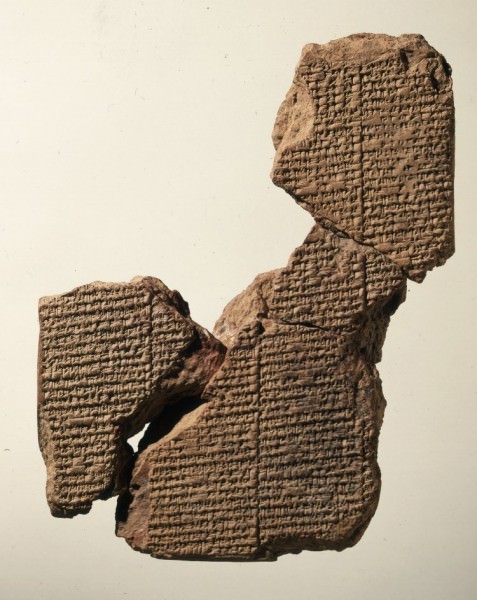
The Atrahasis III Tablet
Enlil finally cannot tolerate the noise anymore and decides to decrease their population. He sends a drought, a pestilence, and a famine upon the people, but each time they appeal to their creator Enki for help and he secretly informs them what to do to save themselves and return balance to the earth. Enlil cannot understand what is happening since somehow everything he sends against the creatures seems to simply help them multiply more abundantly, and so he decides to destroy them all in a great flood.
He convinces the other gods of the necessity of his plan and sets it in motion. Enki disagrees but can do nothing to change Enlil's decree once it has been made. Enki travels to earth to whisper to the sage Atrahasis about what is coming and tells him to build an ark and load two of every kind of animal into it to save them and himself. Atrahasis does as he is told, the flood comes, and life on earth is destroyed.
Enlil almost instantly regrets his decision, and the gods mourn the passing of their creatures, but none of them can do anything about the situation. Enki then tells Atrahasis to open the ark and make a sacrifice to the gods, and he does so. The sweet smell of the sacrifice reaches the heavens and Enlil, although only just upset about his flood, is furious that a human somehow survived. He turns on Enki who explains himself and invites the gods to join him in accepting the sacrifice. As they eat, Enki proposes a new plan by which they will create new creatures who will be less fertile and have shorter lifespans, and Enlil agrees. Human beings are created to experience infertility, mortality, and daily threats to their existence. Although Enki is regarded as the creator, since humanity was his idea, nothing could move ahead without Enlil's consent, and so he was regarded as the great father of men and women.
WORSHIP & ASSIMILATION WITH MARDUK
Enlil continued to be worshiped up through the reign of Hammurabi when the Babylonian god Marduk, son of Enki, became supreme. Marduk, hero of the Enuma Elish, was represented as defeating the forces of chaos, creating human beings and the earth they lived on, and establishing law and agriculture. The most important qualities of Enlil (and some of Enki's) were absorbed into Marduk, who then became the king of the gods not only for the Babylonians but, as the son of Assur, of the Assyrians.
From the Early Dynastic Period until Hammurabi's reign, Enlil was worshiped at his temple in Nippur, the most important religious site in southern Mesopotamia other than Eridu (associated with Enki). According to scholar Jeremy Black, Enlil was so powerful and awe-inspiring that "the other gods might not even look upon his splendour" (76). From Nippur, his worship spread north to Akkad and throughout Sumer, with temples at Kish, Lagash, Babylon, and other cities. Worship of Enlil, as with other Mesopotamian gods, focused on the temple and temple complex which served multiple purposes for the community.
There were no temple services, as one would understand them today, but the temple still served as an integral aspect of every city. People would worship Enlil by bringing offerings with supplications or in thanks for gifts given, and the god's statue and inner sanctum would be cared for by the high priest. As was customary throughout Mesopotamia and Egypt, none but the high priest could enter the presence of the god or commune with him in the temple, and most people's interactions with their deities were through private rituals at home or public festivals.
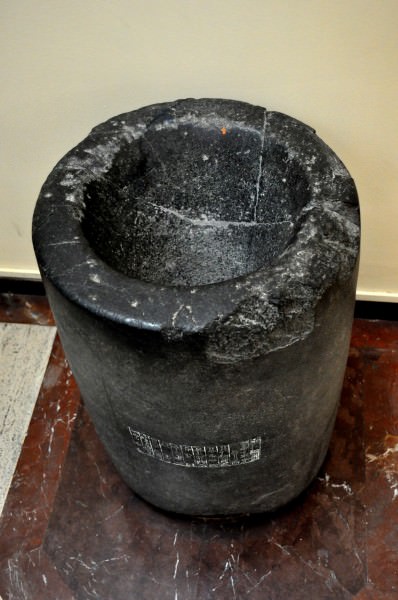
Diorite Mortar
Once Enlil was absorbed into Marduk, his worship declined but he was still honored in shrines in many cities, and even in Babylon it was understood that Enlil and Anu had willingly conferred their power and blessings on Marduk. Enlil's temples were still active during the time of the Neo-Assyrian Empire (912-612 BCE) when the gods Assur, Marduk, and Nabu were considered the supreme deities. According to scholar Adam Stone, "Enlil's power was clearly remembered for even [these gods] were referred to as the 'Assyrian Enlil' or the 'Enlil of the gods'" (2).
After the fall of the Assyrian empire in 612 BCE, Enlil suffered the fate of many Mesopotamian gods associated with Assyrian rule: his statues were destroyed and his temples sacked. Gods who had managed to transcend their association with Assyriain the minds of the people, like Marduk, lived on, and in transferring Enlil's qualities to the younger god, Enlil survived under that name until c. 141 BCE, by which time veneration of Marduk had declined and Enlil was forgotten.
Ennin › Who Was?
Definition and Origins

Ennin (c. 793-864 CE, posthumous title: Jikaku Daishi) was a Japanese Buddhist monk of the Tendai sect who studied Buddhism at length in China and brought back knowledge of esoteric rituals, sutras, and relics. On his return, he published his celebrated diary Nitto Guho Junrei Gyoki and became the abbot of the important Enryakuji monastery on Mount Hiei near Kyoto and, thus, head of the Tendai sect.
Tendai Buddhism had been introduced to Japan by the monk Saicho, also known as Dengyo Daishi (767-822 CE). Based on the teachings of the Chinese Tiantai Sect, Saicho's simplified and inclusive version of Buddhism grew in popularity, and its headquarters, the Enryakuji complex on Mount Hiei outside the capital Heiankyo (Kyoto), became one of the most important in Japan as well as a celebrated seat of learning. Ennin became a disciple of Saicho from 808 CE when he began to study at the monastery, aged just 14.
TRAVELS TO CHINA
Ennin was selected as part of a larger Japanese embassy led by the envoy to the Tang Court, one Fujiwara no Tsunetsugu, to visit China in 838 CE and study there. The main aim was for Ennin to study further the Tendai doctrine at the T'ien-t'ai shan.Ultimately, he would stay there for nine years, studying under various masters and learning in greater depths the tenets and rituals of Buddhism and especially the mysteries of Mikkyo, that is esoteric teachings known only to a very few initiated priests.
IN CHINA ENNIN WAS INITIATED BY THREE DIFFERENT ESOTERIC MASTERS, GOING BEYOND THE LEVEL OF ANY PREVIOUS JAPANESE MONK.
On arrival at Yang-chou and awaiting to be taken to T'ien-tai shan, the monk wasted no time and there and then found priests to teach him shitan, the Indic script used in esoteric texts. He also made his own copies of such texts and underwent an initiation with a priest called Ch'uan-yen. As it turned out Ennin did well, for by the time the Chinese authorities had organised his transport to his original destination he was informed there would be no time to do so if he were not to return to Japan as planned with the embassy. Ennin decided to stay and passed the winter at a monastery in Shantung run by Korean monks.
In the spring Ennin set off for Wutai, an important pilgrimage site and home to some more learned monks who could help satiate his thirst for Buddhist knowledge. Mount Wutai, where the bodhisattva Manjusri was thought to have appeared, was also a centre of esoteric cults. Over the next 50 days, Ennin acquired such techniques as rhythmically chanting the name of Amida Buddha and changing the intonation each repetition.
From 840 to 845 CE Ennin then studied at Ch'ang-an, learning more of Mikkyo, copying texts and mandalas, and being initiated by three different esoteric masters, going beyond the level that the recognised Japanese master and foremost expert Kukai had reached. In 845 CE Ennin, like many Chinese monks, suffered the persecution of anti-Buddhist emperor Wu-tsung, and he was compelled to return to Japan. This was easier said than done and it took two years, the death of Wu-tsung, and a general amnesty for him to finally find a ship that would make the voyage.
ENNIN'S TRAVEL DIARY
Ennin wrote his now famous account of his time in China, the Nitto Guho Junrei Gyoki ('Record of Pilgrimage to China in Search of the Holy Law'). The monk describes the difficulties and dangers of crossing the sea from Japan to China in a time when sailors did not have the compass. On his own trip it took three attempts to finally arrive at port and when he did the embassy was forced to await the slow wheels of Chinese bureaucracy in a region recently hit by a locust-plague-induced famine.

The Spread of Buddhism
The diary contains descriptions of local lore, Chinese inns, life in the monasteries, festivals, and the sights he encountered such as this lion statue which he reports took seven attempts and a good few prayers by the sculptor to complete: "It seems to be walking, and vapors come from its mouth. We looked at it for quite a while, and it looked just as if it were moving" (Keene, 360).
RETURN TO JAPAN & ROYAL APPROVAL
Prior to his return to Japan from China in 847 CE, Ennin famously employed a Shinto diviner and prayed to the Shinto gods Sumiyoshi (protector of sea voyagers) and the Dragon King of the Sea. This was a symbolic instance of the increasing complimentary nature of the Buddhist and Shinto faiths in ancient Japan. The effort was worth it as Ennin did make it back to Japan after another perilous sea trip. With him were 584 Buddhist texts, 21 ritual implements, and several paintings and mandalas for teaching purposes. Previously, Shingon Buddhism had been at the forefront of esoteric teachings in Japan, but now Ennin was armed with material and knowledge to champion the cause of the Tendai sect.
ABBOT OF ENRYAKUJI
In 854 CE Ennin became the Chief Abbot ( Tendei Zasu ) of the Enryakuji monastery, a position he held for over 20 years. The monastery was one of the most important in Japan, and Ennin enjoyed the continued political and financial support of both the imperial court and the powerful Fujiwara clan. A notable achievement during his leadership was the foundation of the Onjoji (aka Miidera) monastery on the lower slopes of the mountain. Other temples credited to Ennin include the Sanbutsudo Hall at Nikko Toshogu on the orders of Emperor Ninmyo (r. 833-850 CE) and on the island of Chikubushima where Ennin set up a statue of Benzaiten (Saraswati) in 834 CE following a dream in which the goddess asked to be enshrined there.

Bell Tower, Enryakuji
Like many other scholar-monks of the period, Ennin was credited with being a gifted sculptor. One example of his work is the wooden copy of the Kannon Bosatsu statue at Asakusa Jinja in Tokyo. The original bronze figure was said to have been caught by fishermen and is a hihutsu or 'hidden image' which may not be revealed to human eyes. Even Ennin's wooden copy is only put on display for one day each year (13th December).
In the politics of the Heian Period (794-1185 CE) the power of monasteries, based on their landholdings, exemption from taxes, and ability to maintain significant armies of armed retainers, meant that inevitably rivalries broke out between them.Enryakuji endured a particularly bitter rivalry with the Kofukuji monastery at Nara. Enryakuji, though, would also split from within when the followers of Ennin and those of Enchin, abbot of Onjoji, decided to go their own way and form the Mountain Order and Jimon Order respectively. There does not seem to have been any significant doctrinal differences between the two groups except a reluctance to emphasise the mystic elements of Buddhism that Ennin preached. The split, which became official following Enchin's death in 891 CE, may also have had more earthly reasons and been due to competition for resources and influence.
Two years after his death in 864 CE, Ennin was given the posthumous title of Jikaku Daishi by the emperor, meaning 'Great Teacher of Compassionate Awareness', in recognition of his contribution to Buddhism and establishing the Tendai Mikkyo sect as the most important officially sanctioned sect in Japan. Tendai Buddhism continued to prosper over the following century with successive emperors favouring the sect and many of the monks ordained at Enryakuji would go on to administer secondary temple site across Japan.
This article was made possible with generous support from the Great Britain Sasakawa Foundation.
Roman Mills › Antique Origins
Ancient Civilizations
The Romans constructed mills for use in agriculture, mining and construction. Around the 3rd century BCE, the first mills were used to grind grain. Later developments and breakthroughs in milling technology expanded their use to crushing ores in mining and such construction activities as cutting wood and marble. Mills became an important part of the Roman economy, decreasing the reliance on human labour, and dramatically increasing productivity and efficiency in many sectors of the Roman economy.
MILLS USED IN AGRICULTURE
Hand-driven Mills
In the agricultural sector, mills allowed for the production of large quantities of flour which was essential to bread production.Before mills were ever invented, humans ground cereals with the use of saddle querns which consisted of a rounded stone pressed manually against a flat stone bed. The first significant innovation in milling came in the late 5th century BCE in Greece, with the introduction of the first milling machine: the Olynthus Mill, also known as the hopper mill. The Olynthus Mill consisted of rectangular-shaped lower and upper stones. The top stone had a long handle and was moved in reciprocal fashion from side to side. The mill also had a hollow cavity (or hopper) with a narrow slot at its centre through which the miller fed the grain.
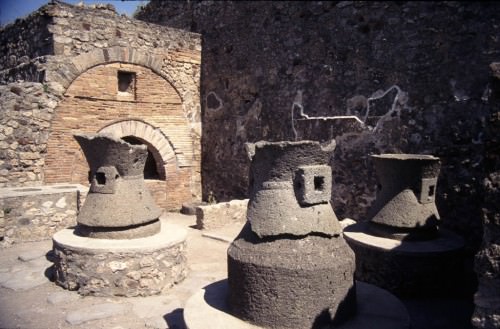
A Pompeii Bakery
Animal-driven Mills
Rotary mills were an improvement over the Olynthus Mill in that cranks could be attached to a beast for grinding. The animal-driven rotary mill appeared around the 3rd century BCE in Italy, one of the best examples being the Pompeian mill which is often associated with the rise of commercial bakeries. Such Pompeian mills were driven by two donkeys harnessed to a wooden frame. The mill consisted of two parts: the lower stone (the meta ) and the upper stone (the catillus ), both made of strong volcanic rock. The upper concave and hour-glass shaped catillus was turned by donkeys. It had a hole through its centre and a hopper at its top through which the miller poured the grain. This stone rotated against the lower meta stone which was slightly convex and immobile. The animal-driven rotary mill saved humans from the drudgery of milling and significantly increased the flour output and quality as donkeys could drive the mill for hours at a time.
Water-driven Mills
The watermill was another significant invention which, according to most historians, came later in the last century BCE, or slightly earlier. In this version of the mill, water striking paddles drove the upper catillus stone with much greater power than had been available from animals. Watermills could therefore produce even greater amounts of flour.
ROMAN MECHANICAL & WATER-DRIVEN MILLING TECHNOLOGY DECREASED RELIANCE ON HUMAN LABOUR & GREATLY IMPROVED PRODUCTIVITY IN MANY SECTORS OF THE ECONOMY, THEREBY, IMPROVING THE DAILY LIVES OF ROMANS.
Many engineering challenges had to be solved for their construction. For example, a constant supply of running water was needed, with the ability to turn it off during inspections and repairs. This was addressed with mill-channels, sometimes several kilometres long, with a system of reservoirs and sluice-gates that could limit or cut off the amount of water admitted to the paddle wheels. In some cases, aqueducts rather than canals ensured a constant water supply.
Another technical challenge was the conversion of the circular movement of the waterwheel to a rotation of the upper catillusor "runner stone" outside the water stream. In the horizontal-wheeled mill version, this movement was transferred directly to the runner stone by means of a vertical shaft. In the vertical-wheeled watermill, the vertical, circular movement of the waterwheel was converted to a horizontal rotation through the use of a right-angle gear. The right-angle gear, invented about 270 BCE, was a transmission system consisting of two cogwheels which increased the velocity of the runner stone, thereby, generating additional power.
There were three variants of the vertical-wheeled mill:
- the undershot mill (water hitting the bottom of the wheel)
- the overshot (water hitting the paddles at the top of the wheel)
- the breastshot water wheel (water hitting the middle of the wheel)
The undershot mill was the simplest, earliest, and most common application of the three.
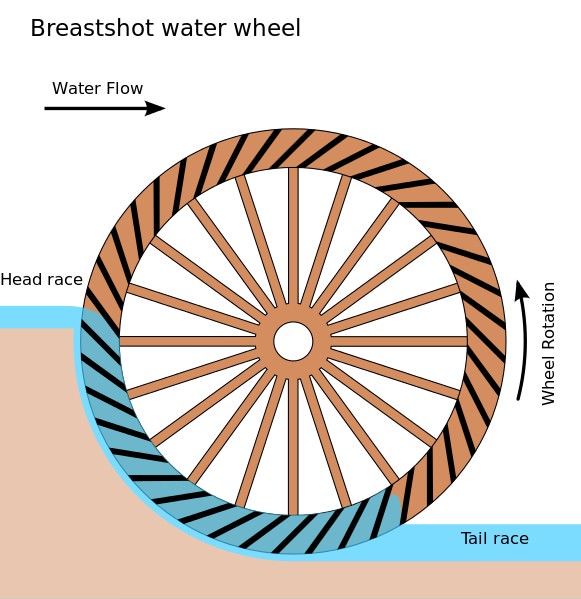
Breastshot Waterwheel
To justify a watermill's construction costs there had to be a large enough concentration of people (between 200 and 400 inhabitants in the surrounding area). When the population's concentration was even greater than this, clusters of mills were built, such as the Janiculum mills (early 3rd century CE) in Rome or the Barbegal complex (early 2nd century CE) in southern France. At the Barbegal complex, for example, an aqueduct could supply water to sixteen overshot wheels while on the slope of the Janiculum hill in Rome, a large number of mills also used aqueduct water to produce flour on an industrial scale from the 3rd through to the 6th century CE.
MILLS USED IN MINING
Stamp mills were used in mining to crush ore from deep deposits into small pieces before further processing. The metal ores needed to be crushed down to a pea or walnut size before it could be smelted. At times, the mills were also used in metal working after the completion of the smelting while the metal was red hot. The presence of stone anvils with marks from trip-hammers at Dolaucothi and other ancient Roman mining sites is proof that stamp mills were widely used in this way to pound extracted ore.
These stamp mills consisted of waterwheels, cams and trip-hammers (mola). They first appeared in Greece around the 3rd century BCE, and then spread across Italy throughout the first century CE. Before this invention, such crushing of ores was done manually, which required a lot of men and effort. As was the case with grain mills, these stamp mills saved greatly on manpower, while also greatly increasing the speed of ore processing. Stamp mills were mostly used in mining applications, but at times were also used to pound and hull grain.
Because water powered these stamping machines, aqueducts were often constructed near mining sites. For example, at the Dolaucothi mines in Wales, or in the Rio Tinto in Spain, long aqueducts were built to power a number of such stamp mills.There, aqueduct water was used as well in ore extraction techniques known as "hushing" and "ground sluicing". Some metal ores such as gold needed to be finely ground in order to release the tiny metal particles from surrounding rock, salts and sands. For this purpose, the Romans constructed watermills similar to the previously mentioned agricultural ones, but these had even harder grinding stones.
MILLS USED IN CONSTRUCTION
The sawmill was another example of a surprisingly-sophisticated machine which consisted of a reciprocating saw powered by a waterwheel. It could cut large amounts of wood or stone, thereby saving enormous amounts of effort and labour. The waterwheel was connected to a rod linked to one or multiple crank-activated saws. The earliest known sawmill was the Hierapolis mill dating back to 250-300 CE. It was the earliest known machine to use a crank with a connecting rod mechanism.A relief on the sarcophagus of Marcus Aurelius Ammianos (dating back to 250-300 CE), in the ancient city of Hierapolis near modern-day Pamukkale in Turkey, gives a clear representation of how it functioned.
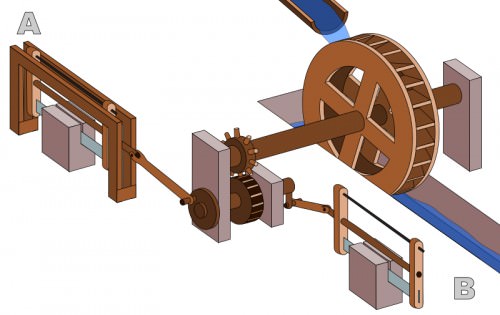
Roman Sawmill
Sawmills were also commonly used to cut marble. A Roman poet called Ausonius writes in an epic poem about the river Moselle in Germany in the late 4th century CE and describes the shrieking sound of a water-powered sawmill used to cut marble. These sawmills were also used to cut various other types of stones. Sawmills dating from the 6th century CE were also found in Gerasa (in modern-day Jordan ) and Ephesus (in modern-day Turkey). Therefore, it is safe to say that they were used throughout the Roman empire for various uses.
CONCLUSION
The invention of mechanically-driven milling technology, and later of watermills, decreased reliance on human labour and greatly improved productivity in many sectors of the Roman economy, thereby, improving the daily lives of Romans. Watermills such as the Janiculum mills in Rome allowed for the production of flour and bread on industrial scales. Stamp mills accelerated ore processing at mining sites throughout the empire, while sawmills allowed for marble and other stones to be cut precisely and at record speeds. Roman milling technology progressed from manual to animal-driven rotary mills in the 1st century BCE, and then to the more complex water-powered and crank activated sawmills of the 3rd century CE. Many of the principles used in the construction of these early machines are still applied to modern mill designs today. Such mills are additional examples of the ingenuity, impressive design, and manufacturing skills of the Romans.
LICENSE:
Article based on information obtained from these sources:with permission from the Website Ancient History Encyclopedia
Content is available under License Creative Commons: Attribution-NonCommercial-ShareAlike 3.0 Unported. CC-BY-NC-SA License